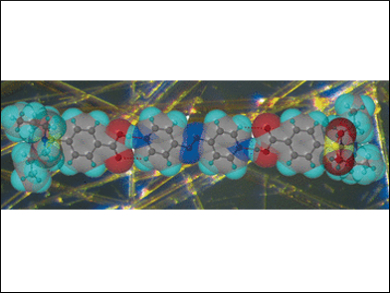Multifunctional Soft Crystals
Crystals are brittle and inelastic? A new class of smart, bendable crystalline organic materials has challenged this view. Panče Naumov, New York University Abu Dhabi, United Arab Emirates, Naba K. Nath, National Institute of Technology, Meghalaya, India, and colleagues have engineered a molecular soft cocrystalline structure that bends and twists reversibly and without disintegration when stimulated by high temperature, mechanical force, or under UV light. This multifunctional quality makes it a robust candidate for advanced molecular electronics and other new materials.
Crystal structures can be quite elastic. This notion has emerged only recently, after the first dynamic and adaptive molecular crystals were reported ten years ago. Crystals that can bend without disintegration are attractive materials in microrobotics, flexible electronics, and optical devices. The researchers have pushed the boundaries of single crystals a bit further. They developed a molecular soft crystal that twists and untwists upon heating and cooling, bends reversibly under UV light, and deforms and reforms responding to mechanical force. Moreover, cracks in the crystals heal themselves over thermal cycling.
Thermally Twistable, Photobendable, Elastically Deformable, and Self-Healing
The crystallinity of molecular organic crystals arises from the packing of the molecule layers. These layers are held in place by intermolecular interactions such as hydrogen bonding, hydrophobic interaction, or interactions between aromatic rings. The crystals the team prepared contain two different molecules, probenecid, a drug compound prescribed to enhance uric acid excretion, and 4,4′-azopyridine, a heteroaromatic azo compound that is known to change from an elongated to a more bent conformation when irradiated by UV light. The single crystals formed from these two molecules consist of stacked 2D layers in a criss-cross arrangement.
Heating, the researchers found, causes a phase change in this structure, a slight rearrangement leading to different packing angles. The long, thin crystal fibrous sheet twists, but not forever: Cooling brings back its original molecular order, and the sheet straightens again. In addition, mechanical bending is possible without cracking, and irradiation with UV light causes rapid, reversible bending.
Not only does the material combine three functionalities—reversible twisting upon heating, elastic bending induced by mechanical force, and rapid, reversible bending under UV light—but it also heals itself: The team reported that splits and small cracks disappear when the crystal is cycled between room temperature and elevated temperatures.
These effects amount to a remarkable multifunctionality of the organic crystal. It is thus a valuable candidate for next-generation solid-state semiconductors, flexible electronics, and other technologies where a combination of apparently contradictory mechanical properties is desired.
- Thermally Twistable, Photobendable, Elastically Deformable, and Self-Healable Soft Crystals,
Poonam Gupta, Durga Prasad Karothu, Ejaz Ahmed, Panče Naumov, Naba K. Nath,
Angew. Chem. Int. Ed. 2018.
https://doi.org/10.1002/anie.201802785




